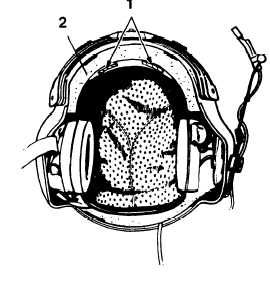TM 1-8415-216-12&P
INITIAL FITTING OF THE HELMET
1.
2.
3.
4.
5.
6.
7.
8.
9.
With the Mask donned, have the operator don the helmet as follows:
a.
Hook the thumbs in the earcups and spread the helmet slightly.
b.
Position the helmet firmly against the forehead; rotate the helmet rearward and down onto the
head.
c.
Press the helmet down firmly with both hands to ensure that the helmet is properly positioned on
the head.
Align the helmet with the forehead reference point.
Adjust the earcups so that they cover the operator’s ears. Check earseal compression and adjust as
necessary in accordance with TM 1-8415-216-12&P, paragraph 4-11.
Fasten and adjust the chinstrap.
Lower the visors to check centering and nose clearance. If necessary, adjust the visors as follows:
a. Loosen the downstop locking screws (one on each side of the visor) and adjust as necessary.
b. When the desired visor position is attained, tighten the screws.
Adjust the nape strap pad for the closest fit possible.
Check the fit of the pad with your index finger.
Ask the operator to evaluate the fit.
If the fit is acceptable, skip to Step 12. If a pressure point exists,
proceed to Step 9.
Ask the operator/wearer to evaluate the fit.
If a pressure point exists in the center of the forehead,
refer to Figure 4-9.1 and add headband fitting pads (1) between the lining, helmet, shock (TPL) and
the lining helmet, shock, (EAL) to either side-of the
pressure point to even the pressure. If any pressure
point remains, lining, helmet shock (TPL) custom fitting
may be required. Refer to paragraph 4-12.
10. Have the operator don the helmet again. If a pressure
point remains, custom-fitting may be required. Refer to
the paragraph 4-12.
NOTE
If the operator cannot be fitted in accordance with the
fitting instructions, contact the United States Army
Aeromedical Research Laboratory (USAARL).
11. Repeat Steps 4-7 for a final fit check with the mask.
NOTE
Adjust ANVIS goggles as necessary for maximized field of
view.
Figure 4-9.2 Headband Fitting Pads
12. If optical systems (ANVIS goggles, AH-1 sight) are used, place the systems in normal operating
position and check for full operational capability in accordance with TM 11-5855-263-10 for ANVIS
goggles and TM 9-1270-212-14&P for the AH-1 sight.
13. Remove the helmet and the mask.
14. Reinstall the brow pad. Ensure the bottom edge of the brow pad is flush with the edge of the energy
absorbing liner.
15. Have the operator don the helmet without the mask. Repeat steps 4-9.
16. After the first flight, recheck and adjust as necessary the helmet straps, the thermoplastic liner, and
the earcups.
Change 1
4-14.3/(4-14.4 blank)


